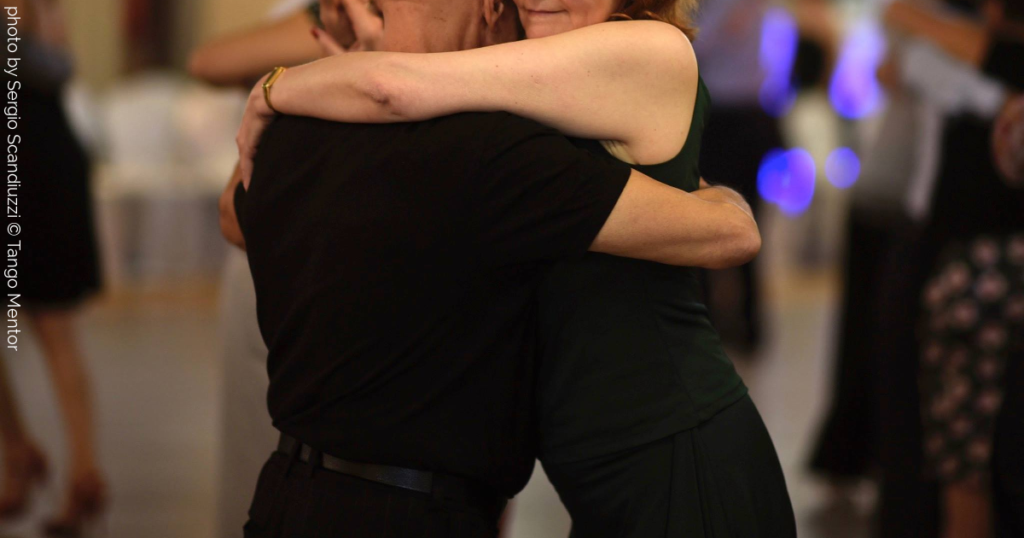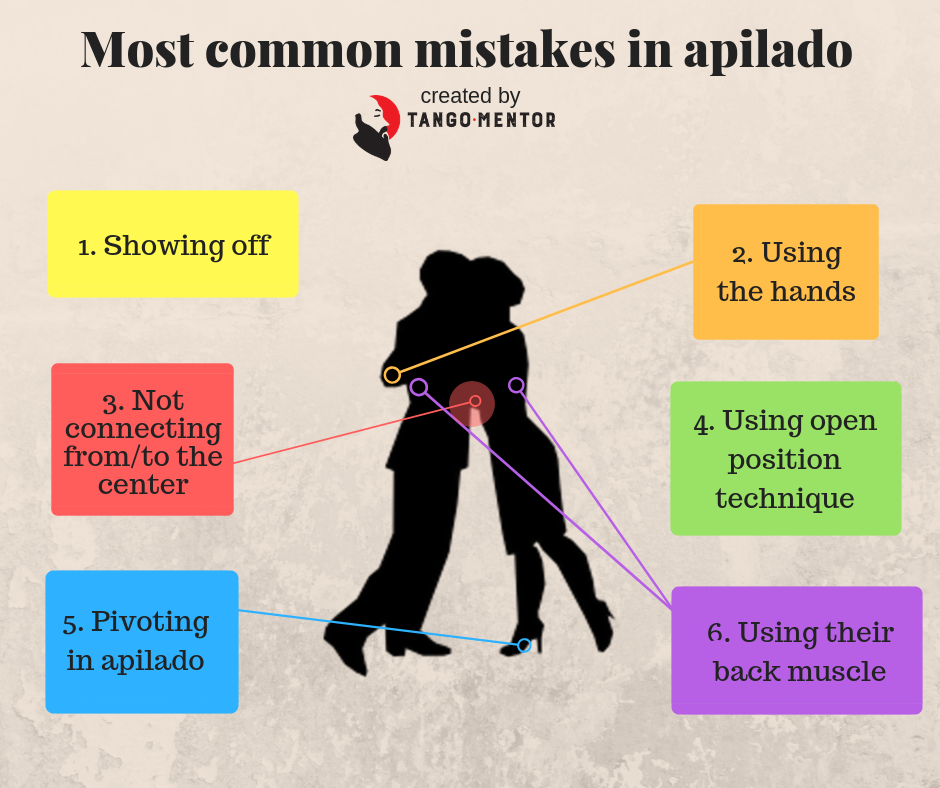 Dancing apilado is not the first idea that comes in mind to many people when they think about creating a more pleasant embrace or deeper connection. This is because there aren’t many teachers helping them learn how to avoid mistakes when they try to lean with their partners.
Dancing apilado is not the first idea that comes in mind to many people when they think about creating a more pleasant embrace or deeper connection. This is because there aren’t many teachers helping them learn how to avoid mistakes when they try to lean with their partners.
I really hope that this article and other similar online materials can be a good starting point on your journey to discover the experience of apilado tango.
A month ago I received an email from John, a reader who said he agrees with many things I write, but he didn’t liked that I use Gavito as an example of apilado dancing.
“His so-called apilado is a commercialized exaggeration for show, not an example to be followed by aspiring social dancers whom you seem to be aiming for. Apilado in Buenos Aires is not leaning on each other although it is an uninterrupted and unbroken chest to chest connection, I give my chest to the woman, she imparts her chest to me and thus we move as one. It becomes natural and non-stressful; too many dancers outside BsAs are stressed and unnatural and adopt unhealthy postures without addressing the body’s most important fundamental weaknesses resulting from today’s sedentary lifestyles.”
What John said is completely true. I agree with him 100%.
But, then, why do I still use Gavito as an example. The answer is simple – because he is famous and respected. I know that what he is doing is just show and an exaggerated version of what social dancer should do – but that exaggeration is necessary for me to show others that apilado dancing is legitimate, and that there is nothing wrong with it, as many are trying to say.
John was not the only one who asked questions, but if you read my articles about apilado carefully, you will notice that I always warn people not to do show moves like Gavito did when they are in a social context. Let me quote one of my articles:
“…people please – have in mind that this is just A performance. Apilado is a technique to be learned, you don’t just lean on your partner saying ‘I am dancing apilado!’”
Also, apilado in social dancing is not drastic like in some of these videos. It is a subtle play of axes – you dance a period leaning and the next moment you are on your own: it all depends on the music and the feeling you want to express. Viewers sometimes even can’t notice if someone is dancing apilado.
Check out what I wrote about apilado in my last article:
Apilado!
And, because of this… I decided to write an article about mistakes dancers do when they (try to) dance apilado.
[Tweet “You don’t just lean on your partner saying “I am dancing apilado!””]
Consider this article as a short list of most common mistakes people make when they are dancing apilado. Of course, different individuals have different issues and every generalization is wrong, but I am sure that this short list can help some dancers improve their approach.
So, you should avoid:
1. Showing off – Dancing like Gavito is cool only for the stage. Please, don’t imagine that this is how one should dance apilado: sharing the axis in social dancing is very subtle and dancers never use it 100% of the time.
So, when you enter the ronda and embrace your partner lean and invite her/him to lean on you in a very subtle way. You never transfer all your weight imagining some drama you’ve seen on Youtube. It is so subtle that sometimes people watching you can’t tell if you are leaning or dancing on your own axis.
Don’t use apilado as a banner telling others “I dance differently.” Apilado is not something to be seen – it is a tool that can make your connection deeper; something that can make you feel your partner better and make him/her feel that you trust and can be trusted.
Hey, sorry to interrupt…
Do you like reading my articles? If you do please consider a small contribution to the existence of this blog.
I don’t sell a book or run ads: I share these articles for free. Unfortunately I also have to pay my bills, so if you see value in my work please consider a small donation/gratuity (the same way you tip your favorite bartender).
From my heart to yours!
Ivica
Securely processed via PayPal
2. Using the hands – Have you seen (or experienced) dancers doing volcadas using their hands? In my opinion it is a recipe for disaster – dancers are not even aware how close they are to hurting their partner’s spine, causing back injury. Good volcadas come from the movement of the man’s torso: her movements are just extension of his movements – they are not forced with his hands and she should not lean on his hands.
It is the same with apilado dancing. It is impossible to dance apilado if the man is not leading with his torso and if she is not trying to connect to his torso (and instead trying to read from his hands).
When dancing apilado the torsos are so close that they are moving as one – not separating even a moment. The hands are completely free and relaxed – you use the hands for hugging, not for leaning, or forcing, or leading… They are relaxed and soft. This is one of the secrets why apilado is such a magical experience – because it is so effortless for both.

3. Not connecting from/to the center – This one is an extension of the previous one. If you are not using your hands, you should use the center. But, be sure that you connect your center to the center of your partner. If you are not able to do that, you will often loose balance and, as a result, you will have to use your hands.
The trick is to connect your center (which is in most cases in your core) with the center of your partner… and try to keep it that way all the time. The complications come when you shift the center: losing the posture, losing the balance, using the hands, uncomfortable embrace etc.
4. Using open position technique – You can’t learn how to dance close embrace practicing open position. The technique is different. You don’t just get to close proximity and (using the same methods) imagine that you are now in close embrace. There are other elements as well, but apilado is one of the most important parts of close embrace.
What is the difference? Well, it has to do with balance transfers, with the flow of the energy, the way you connect and the way you walk.
You will be surprised how much difference there is in all these elements… and also, how much improvement your close embrace dancing will have if you change those details.
For more details, check my article
Dancing in close embrace
5. Pivoting in apilado – As I mentioned in point #1: you never dance apilado 100% of the time. Dancing in close embrace is a game of axis. It’s going back and forward, leaning more and less… you use this fluidity as one more element of expressing the musicality, building the tension and creating magic.
Let me give you an example: you never do pivots in apilado. Well, you can try – but, you will never succeed. Leading ochos or other sequences that include pivoting is a huge mistake. It is responsibility of the man to get her in her axis before leading a pivot.
Leading pivots while in apilado feels bad and also looks terrible.
Let me give you another example: many women automatically do ochos, even when they are in apilado position. Men in this position are usually leading the back cross, also known as ocho milonguero; which is basically ocho without the pivots. And of course, the more the woman is able to trust their partner and lean, the easier is to make the back cross (think about back cross as a reversed volcada).
There are all sorts of complications when a woman is not able to trust her partners: sure, some partners are not trustable, but that is another topic – I talk here about those who know what they are doing.
6. Using their back muscles – If your back hurts after dancing apilado, you are probably one of those dancers who are making this mistake. When you dance apilado, your body should be in a natural position. The spine should be straight and your leaning should come from transferring the balance forward from your ankles.
Using the back muscles happens when dancer are not prepared to trust their partner and to lean on them. Instead of real leaning, they are doing a fake leaning which results in tensing their back muscles and, very visibly, stretching their backside out. This is a very unnatural position… and not very elegant.
The form you have selected does not exist.
Do you find this article interesting? Have you tried dancing in apilado? Send me a line.
I am trying hard to help dancers worldwide with these articles. My mission is to introduce social tango to as many dancers as possible. If you think that my work is useful you can help me by sharing this article with your tango friends. Thanks for that!

Leave a Reply